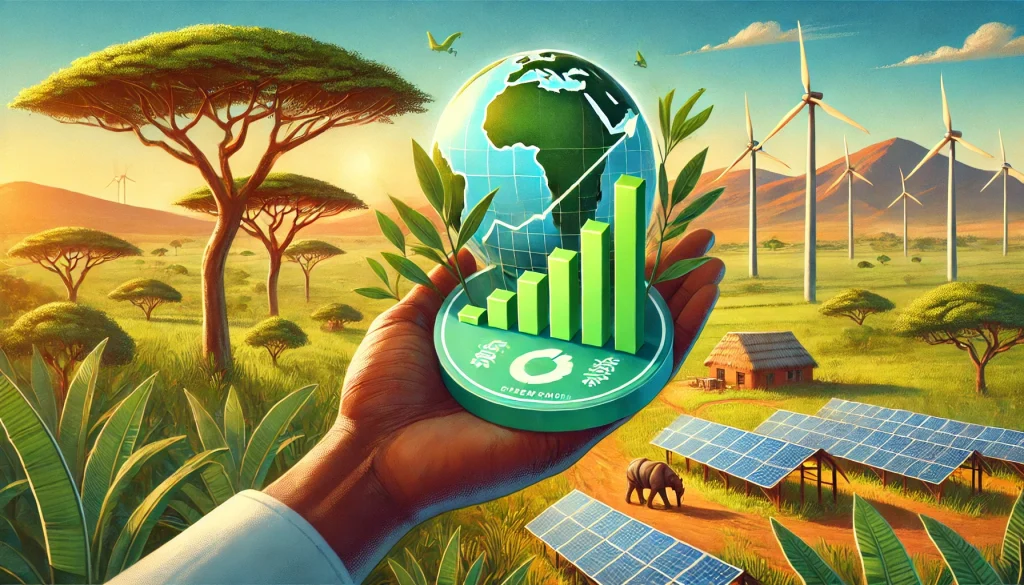Green financing is redefining Africa’s path to sustainable development. This innovative investment strategy focuses on funding projects that benefit the environment while fostering economic growth. In Africa, where sustainable development is crucial, green financing stands as a transformative force, promising a future where economic advancement aligns with environmental preservation.
Africa, with its rich biodiversity and expanding economies, is increasingly embracing green financing to fuel sustainable initiatives. This approach attracts international investors and stimulates local development, opening avenues for renewable energy, sustainable agriculture, and eco-friendly infrastructure. Through strategic investments, African nations are rising as leaders in global sustainability efforts.
What is green financing?

At its core, Green financing involves financial investments in projects that contribute to environmental sustainability. Unlike traditional financing, it explicitly supports initiatives with positive environmental outcomes, such as renewable energy, eco-friendly urban development, and conservation projects. The distinction lies in the targeted environmental benefits. While conventional loans prioritize financial returns, green loans balance financial gains with ecological impact, promoting resource efficiency and reducing carbon emissions.
Key financial instruments
Green bonds are a cornerstone of financing, offering investors a way to fund environmental projects. These bonds pay interest like traditional bonds but are exclusively allocated for sustainability initiatives. Green loans also support eco-friendly projects, often with favorable terms for borrowers committed to sustainability. Sustainable investment funds further attract investors seeking portfolios emphasizing environmental impact.
Growth of green financing in Africa
Africa has witnessed a surge in green financing, driven by the need for sustainable development. Countries like South Africa, Kenya, and Nigeria lead the way, leveraging green financing to address energy shortages and environmental concerns. International partnerships, including the World Bank and African Development Bank, play a crucial role in promoting sustainable projects. These collaborations enhance Africa’s capacity to implement large-scale green initiatives, cementing financing as a key development strategy.
Leading nations in Africa
South Africa, Kenya, and Nigeria are pioneering green financing efforts, implementing projects that underscore the continent’s commitment to sustainable development. South Africa’s solar power initiatives and Kenya’s advancements in geothermal energy highlight the region’s potential to lead in renewable energy. Nigeria, with its substantial oil reserves, is shifting towards renewables to diversify its energy mix and reduce dependency on fossil fuels. This shift is emblematic of the continent’s broader transition towards sustainable energy solutions.
Role of international organizations
Organizations such as the World Bank and the African Development Bank (AfDB) are pivotal in scaling up green financing across Africa. By providing both financial support and strategic guidance, these bodies help mobilize resources for green projects, catalyzing further investments and encouraging regional cooperation. Their involvement ensures projects meet international standards for sustainability and environmental impact.
These institutions also play a crucial role in capacity-building, equipping African nations with the knowledge and technical expertise needed to manage and implement green initiatives successfully. By fostering collaborations and providing critical funding, these organizations are instrumental in accelerating the continent’s shift towards a low-carbon economy.
Key sectors benefiting from green financing
Green financing significantly impacts sectors like renewable energy, sustainable agriculture, and eco-friendly infrastructure. Renewable energy projects, including solar, wind, and hydroelectric power, receive substantial funding, promoting energy independence and reduced emissions. In agriculture, green financing supports eco-friendly farming practices, boosting productivity while preserving biodiversity. Sustainable infrastructure investments fund urban projects emphasizing resource efficiency and minimal environmental impact.
Renewable energy initiatives
Renewable energy is a major beneficiary of green financing, with projects harnessing Africa’s abundant solar, wind, and hydro resources. Solar farms in South Africa and wind energy projects in Kenya are prime examples of how green financing catalyzes renewable energy adoption.
By investing in these clean energy sources, African nations can meet growing energy demands sustainably, decreasing reliance on fossil fuels and lowering greenhouse gas emissions. The emphasis on renewables not only curbs climate change effects but also stimulates job creation in emerging energy sectors, fostering broader economic development.
Sustainable agriculture and infrastructure
Agriculture, a cornerstone of many African economies, benefits greatly from green financing. By funding sustainable practices, such as organic farming and efficient water management, green financing promotes agricultural productivity while preserving ecological balance. Similarly, investments in infrastructure focus on sustainable urban development, supporting projects that reduce environmental impact. From eco-friendly transportation systems to green building initiatives, these investments enhance urban sustainability.
Challenges and opportunities in green financing
Despite its potential, green financing in Africa faces challenges such as limited access to credit, bureaucratic hurdles, and economic risks. However, opportunities lie in attracting foreign investments and fostering local entrepreneurship in green sectors. To mitigate risks, African nations are adopting strategies like public-private partnerships and risk-sharing mechanisms. These approaches ensure project success while promoting a supportive ecosystem for green industries.
Investing in the future
Green financing opens new pathways for sustainable economic growth in Africa, presenting unique opportunities for investment in a future-focused economy. By prioritizing green projects, the continent can harness its natural resources responsibly, laying a robust foundation for ongoing development.
With continued expansion of green financing, Africa stands poised to attain significant economic and environmental milestones. Investment in green technologies and infrastructure represents not just a pathway to sustainability but also a lucrative opportunity that promises substantial returns. Embracing these opportunities equips Africa to thrive in a rapidly changing global landscape, securing a prosperous and sustainable future.



